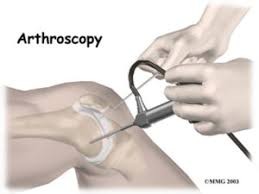KNEE & SHOULDER ARTHROSCOPY
What Is Arthroscopy ?
 The shoulder joint is a ball and socket joint. It is designed to give a large range of movement to allow you to move your arm and hand. It has a large ball (head of humerus) and a smaller, shallow socket (glenoid). The advantage of this design is that a very large range of movement at the shoulder is possible, the disadvantage however is that the shoulder can become unstable.
The shoulder joint is a ball and socket joint. It is designed to give a large range of movement to allow you to move your arm and hand. It has a large ball (head of humerus) and a smaller, shallow socket (glenoid). The advantage of this design is that a very large range of movement at the shoulder is possible, the disadvantage however is that the shoulder can become unstable.
Shoulder stability is controlled by various structures. The most important ones are:
- Ligaments; which hold the bones together
- A rim of cartilage; called the Labrum which deepens the socket and gives stability.
- Muscles; which keep the shoulder blade and joint in the correct position when moving or using the arm.
 Arthroscopy can be used to diagnose several knee problems, such as a torn meniscus or cruciate ligament tear, or a malaligned patella (kneecap). It is commonly used to reconstruct ligaments in the joint and also repair meniscus. Shoulder arthroscopy can be used to diagnose and treat problems like rotator cuff tear (tendon injury), labrum (lining of shoulder joint) damage or bursitis.
Arthroscopy can be used to diagnose several knee problems, such as a torn meniscus or cruciate ligament tear, or a malaligned patella (kneecap). It is commonly used to reconstruct ligaments in the joint and also repair meniscus. Shoulder arthroscopy can be used to diagnose and treat problems like rotator cuff tear (tendon injury), labrum (lining of shoulder joint) damage or bursitis.
It is usually a day case operation with limited risks, and the result is good for most patients. Your recovery time and prognosis will depend on the severity of the problem and the complexity of the required procedure.
Do I Need Knee Arthroscopy ?
Arthroscopic surgery can diagnose and treat knee injuries, including:
 
- torn anterior or posterior cruciate ligaments
- torn meniscus (the cartilage between the bones in the knee)
- patella maltracking
- pieces of torn cartilage or bone that are loose in the joint
- fractures in the knee bones
- swollen synovium (the lining in the joint)
Do I Need Shoulder Arthroscopy ?
- Repair of torn rotator cuff (tendon)
- Repair of torn labrum (covering of the joint)
- Synovitis (swollen lining)
- Bursitis (Swollen bursa)
- Capsular release for frozen shoulder
- Some fractures involving shoulder joint
What Happens During A Knee & Shoulder Arthroscopy ?
- Local (numbs your knee or arm only)
- Regional (numbs you from the waist down)
- General (puts you completely to sleep)
If you’re awake, you may be able to watch the procedure on a monitor.
The procedure begins by making a few small incisions (cuts), in your joint. Sterile salt water, or saline, will then pump in to expand the joint. This makes it easier for the surgeon to see inside the joint. The arthroscope enters one of the cuts and the surgeon will look around in your joint using the attached camera. The surgeon can see the images produced by the camera on the monitor in the operating room. When the surgeon locates the problem, small tools are inserted into the incisions to correct the issue. After the surgery, the surgeon drains the saline from your joint and closes your cuts with stitches. Dr Sarda uses state of the art equipment and has lot of experience in arthroscopic surgery to be able to provide the best outcomes for his patients.
This surgery isn’t very invasive. For most people, knee arthroscopy takes less than an hour, shoulder arthroscopy can take a bit longer depending on the procedure. Usually you will be able to go home on the same day for recovery. You should use an ice pack on the operated part and a dressing. The ice will help reduce swelling and minimize your pain.
Your doctor will give you an exercise regimen to follow at home to help you recover, or will recommend a physical therapist to see until you’re able to use your knee or shoulder normally. The exercises are necessary to help restore your full range of motion and to strengthen your muscles. With the proper care, your outlook after having this procedure is excellent.

